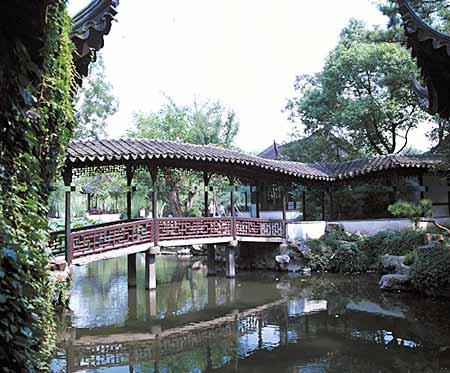
 |
| The Small Flying Rainbow Bridge in the Humble Administrator's Garden reflects the perfect combination of a corridor and a bridge. (CNTV) |
The Classical Gardens of Suzhou are representations of the architecture in the southern area of the Yangtze River in the Ming and Qing dynasties (from the early 14th to 20th century), and reflect the high civilization of the southern area of the Yangtze River in this period. It influenced the architectural styles of the whole southern area of the Yangtze River, and was the leading influence in design, planning, layout, beauty and technique of folk architecture and reflects the scientific and technological level and artistic achievement of city construction during that time.
Rich social and cultural connotations
One important feature of the Classical Gardens of Suzhou is that it is not only a product of history and culture, but also is the carrier of traditional Chinese thinking and culture. This feature is reflected in the name of the halls, steles, couplets, stones, sculptures, decorations and other allegoric things in the gardens. These things are not only exquisite art pieces that decorate the garden, but also store a large number of historical, cultural, ideological and scientific information, and have rich material and spiritual content. Some of them reflect and spread the philosophical views and schools of thought of Confucianism, Buddhism and Taoism, some advocate the philosophy of life and cultivate noble sentiments, while others decorate and render the landscape with the help of classical poetry and helps people relax during tours. The allegories show conceptual beauty and satisfy people's spiritual desire. The collected and well-preserved works of famous calligraphers in ancient China are precious artworks and have high value as culture relics. In addition, as mansions combining houses and gardens, the architectural styles of the Classical Gardens of Suzhou reflect the lifestyle and manner as well as customs of ancient Chinese people who lived in the southern area of the Yangtze River. Furthermore, they are materials for learning and studying ancient folk customs in the southern area of the Yangtze River.

















 Wild Siberian tiger kills cattle in NE China
Wild Siberian tiger kills cattle in NE China


![]()
